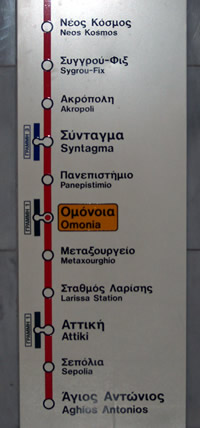 The construction of the Acropolis Station of the Metropolitan Railway (Metro) necessitated an
urgent archaeological excavation on the eastern side of the Makrygianni plot, between Makrygianni
and Athanasiou Diakou Streets which took place from 1993 to 1996.
The excavation brought to light a section of the southern part of the ancient and medieval city of
Athens and supplied important historical information concerning its development. Thats the Acropolis Stop third from the top left. See ancient Athens map. See medeival Athens map.
The construction of the Acropolis Station of the Metropolitan Railway (Metro) necessitated an
urgent archaeological excavation on the eastern side of the Makrygianni plot, between Makrygianni
and Athanasiou Diakou Streets which took place from 1993 to 1996.
The excavation brought to light a section of the southern part of the ancient and medieval city of
Athens and supplied important historical information concerning its development. Thats the Acropolis Stop third from the top left. See ancient Athens map. See medeival Athens map.
Human presence in the area of the excavation is established at the end of the third millennium BC turning the early Helladic period. From the middle Helladic until the proto-geometric times the areas was used as a burial ground by the inhabitants of the near by settlements. From the 8th C BC the sites ceased to be used a s a burial ground and was used for habitation, especially after the erection of the Themistoklean Wall in 479 BC and the inclusion of the area within the fortified part of the ancient city.
 However only fragmented remains (of roads, houses and workshops)
dating from the geometric, archaic and Classical periods have survived, dispersed throughout the
whole of the excavation.
The planning and construction of earth roads anew in the second half of the 4th C BC finally
completed the urban planning of the area. The excavation revealed six intersecting ancient roads which were flanked on both sides by houses, shops and workshops. The lime stone foundations
of a small temple, probably dedicated to a deity patron of roads, Hermes, Hecate or
Apollo-Agiyeus were found at the intersections of roads one and two.
However only fragmented remains (of roads, houses and workshops)
dating from the geometric, archaic and Classical periods have survived, dispersed throughout the
whole of the excavation.
The planning and construction of earth roads anew in the second half of the 4th C BC finally
completed the urban planning of the area. The excavation revealed six intersecting ancient roads which were flanked on both sides by houses, shops and workshops. The lime stone foundations
of a small temple, probably dedicated to a deity patron of roads, Hermes, Hecate or
Apollo-Agiyeus were found at the intersections of roads one and two.
 The houses were simple, with small inside courtyards where wells were dug to draw drinking water
and underground cisterns to collect rain water for the needs of the household and its hygienic
facilities.
The houses were simple, with small inside courtyards where wells were dug to draw drinking water
and underground cisterns to collect rain water for the needs of the household and its hygienic
facilities.
Often a single house had more than one cistern, interlinked by underground tunnels cut into the rock. 4 such cisterns and over 50 wells were located during the excavation. When the wells were no longer in use they became a dumping ground for household objects, so their excavation revealed plentiful finds such as vases and other vessels, household utensils, oil lamps, clay toys, fragments of sculpture or architectural parts, etc.
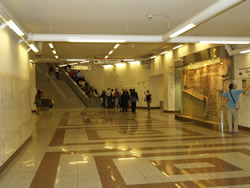 The entire area of the excavation bore a dense network of clay pipes which conveyed the waste
from the houses and the workshops to the large underground sewers that ran along roads one and
two.
The entire area of the excavation bore a dense network of clay pipes which conveyed the waste
from the houses and the workshops to the large underground sewers that ran along roads one and
two.
There does not seem to be any great change on the area during the Imperial Roman period: 1st-3d C AD. Most of the roads continued to be in use and were regularly repaired, similarly the houses underwent repairs of varying degrees.
The important changes occurred during the late Roman Early Christian era 4th - 6th centuries AD. At that time the area was occupied by a large cluster of buildings with spacious room, mosaic floors and baths. One of the rooms was circular, while another bore apses at its narrow sides.
Below is a model in the Center for Acropolis Studies Building houses in the old Bavariam Military Hospital you see.
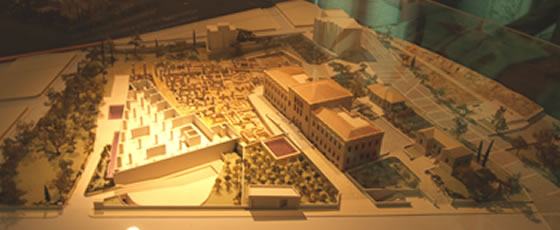
The building was similar to the great villas that were erected in other parts of the city at that time some of which have been identified as schools of Philosophy. The cluster was destroyed at the end of the 6th or beginning of the 7th C AD and during the subsequent centuries other humbler building were built upon its ruins.

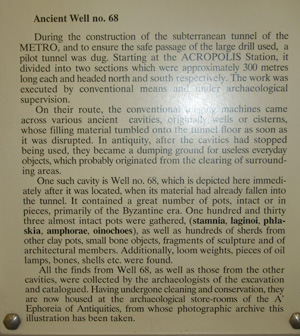 The area enjoyed a new period of prosperity during the Middle Byzantine period 10th - 12th C AD.
The area enjoyed a new period of prosperity during the Middle Byzantine period 10th - 12th C AD.
The houses from that time had basements where large storage jars were built in the ground; workshops were also established like the tannery that came to light in the NE end of the excavation as well as a small Christian Cemetery with underground vaulted tombs.
In the early 13th C AD the area was finally abandoned, following the decline and decrease of the city in the years after its conquest by the Franks. During the Frankish and the Ottoman occupation the area was used exclusively for agricultural purposes.
After the 1821 War of Independence, General Makrygianni's bought land in the area which has since borne his name, while 1834 a large military hospital was established to meet the needs of the Bavarian army, to the plans of the German engineer Wilhelm von Weiler. Its is this building that now houses the Center for Acropolis Studies. Also see the New Acropolis Museum

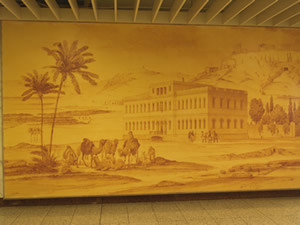
The sculptural decoration of the Parthenon consists of three units, the metopes, the frieze and the pediments and is the work of Phidias and his pupils. The pediment sculptures 438-432bc are compositions of figures of supernatural size isolated or in groups, cut in the round from pendelic marble. According to the 2nd Century traveler Pausanius, the theme of the east pediment was the birth of the goddess Athena, and of the west pediment the fight between Athens and Poseidon over the protection of Attika.
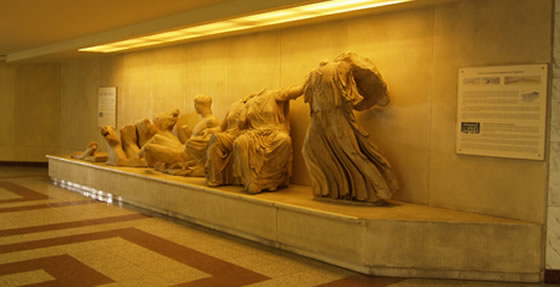
The figures at the center of the east pediment have not survived. They would have been the main participants in the event of Athena's birth from the head of Zeus, ie. Zeus, Hera and Athens herself, surrounded by the other Olympian gods. The chariots of Helios (sun) and Selene (Moon) occupied the two corners of the pediment, delineating the time-span of the event.
 The casts that are exhibited here are from the original sculptures that decorated the left side of the pediment. Depicted from left to right are Helios and the heads of the four horses of his chariot as he rises from the waves of Oceanos (ocean); opposite him, Dionysos, half lying on a rock which is covered by his garment and the panther skin he usually wears. The there follow two seated goddesses, Demeter and Kore (daughter), a standing figure (Hebe or Artemis) who moves towards them, announcing the event of Athena's birth.
The casts that are exhibited here are from the original sculptures that decorated the left side of the pediment. Depicted from left to right are Helios and the heads of the four horses of his chariot as he rises from the waves of Oceanos (ocean); opposite him, Dionysos, half lying on a rock which is covered by his garment and the panther skin he usually wears. The there follow two seated goddesses, Demeter and Kore (daughter), a standing figure (Hebe or Artemis) who moves towards them, announcing the event of Athena's birth.
The central group, with the birth of the goddess was lost when the Parthenon was converted to a Christian Church in the 5th C AD. Modern reconstructions have been based on the fragments of torso's found on the Acropolis and in accordance with other representations of the same subject. The sculptures that remain in their original positions on the building were sketched by J. Carey (1674). They were almost entirely removed by Lord Elgin from 1801 onwards and, since 1816 they are in the British Museum where they are exhibited. Now the two inside horses from the chariots of both Helios and Selene are in the Acropolis Museum.